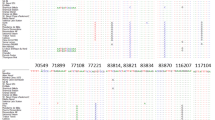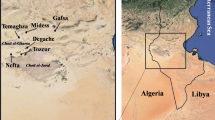Abstract
The genus Corylus, a member of the birch family Betulaceae, includes several species that are widely distributed throughout temperate regions of the Northern Hemisphere. The development of microsatellites or simple sequence repeats (SSRs) for non-coding regions of the chloroplast genome and their higher sequence variation compared with coding regions has provided a higher resolution tool for the study of cultivars and closely related taxa. Chloroplast polymorphisms provide a marker system to evaluate the genetic structure of plant populations. This study investigated genetic diversity in three cultivars and 32 genotypes of Corylus avellana L. from Portugal: 13 wild genotypes and 19 Portuguese landraces. Four of ten cpSSR loci were polymorphic, with diversity indices ranging from 0.111 to 0.244. Eleven chlorotypes were detected, and their relationships were analyzed using a network model. Haplotype A was most frequent in landraces and cultivars. Four chlorotypes (H, I, J and L) were found only in wild hazelnuts. The diversity of chlorotypes in the wild hazels, and the limited number reported in cultivars, suggests that northern Portugal was a refuge for hazel during the last ice age.


Similar content being viewed by others
References
Bandelt HJ, Foster P, Rohl A (1999) Median-joining networks for inferring intraspecific phylogenies. Mol Biol Evol 16:37–48
Bassil NV, Botta R, Mehlenbacher SA (2005) Microsatellite markers in the hazelnut: isolation, characterization and cross-species amplification in Corylus. J Am Soc Hortic Sci 130:543–549
Birky CW (1988) Evolution and variation in plant chloroplast and mitochondrial genomes. In: Gottlieb L, Jain S (eds) Plant evolutionary biology. Chapman and Hall, London, pp 23–53
Birky CW (1995) Uniparental inheritance of mitochondrial and chloroplast genes: mechanisms and evolution. Proc Nat Acad Sci USA 92:11331–11338
Boccacci P, Botta R (2009) Investigating the origin of hazelnut (Corylus avellana L.) cultivars using chloroplast microsatellites. Genet Resour Crop Evol 56(6):851–859
Boccacci P, Akkak A, Bassil NV, Mehlenbacher SA, Botta R (2005) Characterization and evaluation of microsatellite loci in European hazelnut (Corylus avellana L.) and their transferability to other Corylus species. Mol Ecol Notes 5:934–937
Boccacci P, Akkak A, Botta R (2006) DNA typing and genetic relationships among European hazelnut (Corylus avellana L.) cultivars using microsatellite markers. Genome 49:598–611
Dumolin S, Démesure B, Petit RJ (1995) Inheritance of chloroplast and mitochondrial genomes in pedunculate oak investigated with an efficient PCR method. Theor Appl Genet 91:1253–1256
Ennos RA, Sinclair WT, Hu XS, Langdon A (1999) Using organelle markers to elucidate the history, ecology and evolution of plant populations. In: Hollingsworth PM, Bateman RM, Gornall RJ (eds) Molecular systematics and plant evolution. Taylor and Francis, London, pp 1–19
FAOstat (2008) Agriculture data. http://faostat.fao.org/site/408/default.aspx
Galvão HP (1968) A cultura da aveleira. Série de divulgação 36. Direcção-Geral dos Serviços Agrícolas, Serviço de Informação Agrícola, Lisboa
Gokirmak T, Mehlenbacher SA, Bassil NV (2009) Characterization of European hazelnut (Corylus avellana) cultivars using SSR markers. Genet Resour Crop Evol 56:147–172
Gürcan K, Mehlenbacher SA (2010) Development of microsatellite marker loci for European hazelnut (Corylus avellana L.) from ISSR fragments. Mol Breed 26:551–559. doi:10.1007/s11032-010-9464-7
Gürcan K, Mehlenbacher SA, Botta R, Boccacci P (2010) Development, characterization, segregation, and mapping of microsatellite markers for European hazelnut (Corylus avellana L.) from enriched genomic libraries and usefulness in genetic diversity studies. Tree Genetics Genom 6:513–531. doi:10.1007/s11295-010-0269-y
Hewitt GM (1996) Some genetic consequences of ice ages, and their role in divergence and speciation. Biol J Linn Soc 58:247–276
Hewitt GM (2000) The genetic legacy of the Quaternary ice ages. Nature 405:907–913
Huntley B, Birks HJB (1983) An atlas of past and present pollen maps for Europe: 0–13000 years ago. Cambridge University Press, Cambridge
Ishii T, Xu Y, McCouch SR (2001) Nuclear- and chloroplast-microsatellite variation in A-genome species of rice. Genome 44:658–666
Kasapligil B (1972) A bibliography on Corylus (Betulaceae) with annotations. Annu Rep North Nut Growers Assoc 63:107–162
Li J, Ge XJ, Cao HL, Ye WH (2007) Chloroplast DNA diversity in Castanopsis hystrix populations in south China. Forest Ecol Manag 243:94–101
Lira CF, Cardoso RS, Ferreira CG, Cardoso MA, Proven J (2003) Longterm population isolation in the endangered tropical tree species Caesalpinia echinata Lam. revealed by chloroplast microsatellites. Mol Ecol 12:3219–3225
McCauley DE (1995) The use of chloroplast DNA polymorphism in studies of gene flow in plants. Trends Ecol Evol 10:198–202
Navascues M, Emerson BC (2005) Chloroplast microsatellites: measure of genetic diversity and the effect of homoplasy. Mol Ecol 14:1333–1341
Pakkad G, Ueno S, Yoshimaru H (2008) Genetic diversity and differentiation of Quercus semiserrata Roxb. in northern Thailand revealed by nuclear and chloroplast microsatellite markers. For Ecol Manag 255:1067–1077
Palmé AE, Vendramin GG (2002) Chloroplast DNA variation, postglacial recolonization and hybridization in hazel, Corylus avellana. Mol Ecol 11:1769–1779
Petit RJ, El Mousadik A, Pons O (1998) Identifying populations for conservation on the basis of genetic markers. Conserv Biol 12:844–855
Petit RJ, Aguinagalde I, de Beaulieu JL, Bittkau C, Brewer S, Cheddadi R, Ennos R, Fineschi S, Grivet D, Lascoux M, Mohanty A, Müller-Starck G, Demesure-Musch B, Palmé A, Martín JP, Rendell S, Vendramin GG (2003) Glacial refugia: hotspots but not melting pots of genetic diversity. Science 300:1563–1565
Powell W, Morgante M, Andre C, McNicol JW, Machray GC, Doy Tingey SV, Rafalski JA (1995) Hypervariable microsatellites provide a general source of polymorphic DNA markers for the chloroplast genome. Curr Biol 5:215–222
Powell W, Morgante M, McDevitt R, Vendramin GC, Rafalski JA (1996) Polymorphic simple sequence repeat regions in chloroplast genomes: applications to the population genetics of pines. Proc Natl Acad Sci USA 92:7759–7763
Provan J, Russell JR, Booth A, Powell W (1999) Polymorphic chloroplast simple sequence repeat primers for systematic and population studies in the genus Hordeum. Mol Ecol 8:505–511
Provan J, Powell W, Hollingsworth PM (2001) Chloroplast microsatellites: new tools for studies in plant ecology and evolution. Trends Ecol Evol 16:142–147
Radetzky R (1990) Analysis of mitochondrial DNA and its inheritance in Populus. Curr Genet 18:429–434
Rajora OP, Dancik BP (1992) Chloroplast DNA inheritance in Populus. Theor Appl Genet 84:280–285
Rajora OP, Mosseler A (2001) Challenges and opportunities for conservation of forest genetic resources. Euphytica 118:197–212
Sebastiani SF, Carnevale S, Vendramin GG (2004) A new set of mono- and dinucleotide chloroplast microsatellites in Fagaceae. Mol Ecol Notes 4:259–261
Silva AP, Santos FA, Santos AS, Sousa VS, Lopes AD, Assunção AV, Mota BS, Leme PC, Carvalho JL, Borges OM, Ribeiro RS, Fernandes ST (2004) Variedades de aveleiras. Agro 162 Project Report, National Publication
Streiff R, Labbe T, Bacilieri R, Steinkellner H, Glössl J, Kremer A (1998) Within-population genetic structure in Quercus robur L. and Quercus petraea (Matt.) Liebl. assessed with isozymes and microsatellites. Mol Ecol 7:317–328
Streiff R, Ducousso A, Lexer C, Steinkellner H, Gloessl J, Kremer A (1999) Pollen dispersal inferred from paternity analysis in a mixed oak stand of Quercus robur L. and Q. petraea (Matt.) Liebl. Mol Ecol 8:831–841
Taberlet P (1998) Biodiversity at the intraspecific level: the comparative phylogeographic approach. J Biotechnol 64:91–100
Taberlet P, Fumagalli L, Wust-Saucy AG, Cosson JF (1998) Comparative phylogeography and postglacial colonization routes in Europe. Mol Ecol 7:453–464
Tasias Valls J (1975) El avellano en la provincia de Tarragona. EXCMA Diputación Provincial de Tarragona, Tarragona, Spain
Thompson MM, Lagerstedt HB, Mehlenbacher SA (1996) Hazelnuts, in: Janick J, Moore JN (eds) Fruit breeding: nuts, vol 3. Wiley, New York, pp 125–184
Trotter A (1921) Contributo alla storia colturale del nocciuolo nella Campania. Ristampa di una comunicazione fatta al Congresso di Arboricoltura Meridionale, Napoli, Italy, pp 3–19
Tzedakis PC, Lawson IT, Frogley MR, Hewitt GM (2002) Buffered tree population changes in Quaternary refugium: evolutionary implication. Science 292:267–269
Ueno S, Setsuko S, Kawahara T, Yoshimaru H (2005) Genetic diversity and differentiation of the endangered Japanese endemic tree Magnolia stellata using nuclear and chloroplast microsatellite markers. Conserv Genet 6:563–574
Weising K, Gardner RC (1999) A set of conserved PCR primers for the analysis of simple sequence repeat polymorphisms in chloroplast genomes of dicotyledonous angiosperms. Genome 42:9–19
Yeh FC, Yang RC, Boyle TBJ, Ye ZH, Mao JX (1999) Popgene version 1.32, the user-friendly shareware for population genetic analysis. Molecular Biology and Biotechnology Centre, University of Alberta, Edmonton
Acknowledgments
This work was supported by the PhD grant SFRH/BD/40686/2007 attributed from the Portuguese Foundation of Science and Technology (FCT).
Author information
Authors and Affiliations
Corresponding author
Rights and permissions
About this article
Cite this article
Martins, S., Simões, F., Mendonça, D. et al. Chloroplast SSR genetic diversity indicates a refuge for Corylus avellana in northern Portugal. Genet Resour Crop Evol 60, 1289–1295 (2013). https://doi.org/10.1007/s10722-012-9919-2
Received:
Accepted:
Published:
Issue Date:
DOI: https://doi.org/10.1007/s10722-012-9919-2




